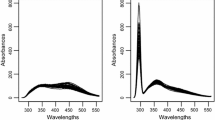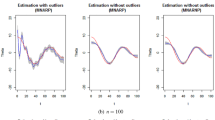Abstract
Functional linear concurrent regression model is an important model in functional regression. It is usually assumed that realizations of functional covariate are independent and observed precisely. But in practice, the dependence across different functional sample curves often exists. Moreover, each realization of functional covariate may be contaminated with noise. To address this issue, we propose a novel estimation method, which makes full use of dependence information and filters out the impact of measured noise. Then, we extend the proposed method to partially observed functional data. Under some regular conditions, we establish asymptotic properties of the estimators of the model. Finite-sample performance of our estimation is illustrated by Monte Carlo simulation studies and a real data example. Numerical results reveal that the proposed method exhibits superior performance compared with the existing methods.




Similar content being viewed by others
References
Bathia N, Yao Q, Ziegelmann F (2010) Identifying the finite dimensionality of curve time series. Ann Stat 38(6):3352–3386
Bosq D (2012) Linear processes in function spaces: theory and applications, vol 149. Springer Science and Business Media
Bücher A, Dette H, Heinrichs F (2019) Detecting deviations from second-order stationarity in locally stationary functional time series. Annals of the Institute of Statistical Mathematics pp 1–40
Cerqueira V, Torgo L, Mozetič I (2020) Evaluating time series forecasting models: an empirical study on performance estimation methods. Mach Learn 109(11):1997–2028
Chang J, Chen C, Qiao X, Yao Q (2022) An autocovariance-based learning framework for high-dimensional functional time series, arXiv:2008.12885v3
Chen C, Guo S, Qiao X (2022) Functional linear regression: dependence and error contamination. J Bus Econ Stat 40(1):444–457
Chen K, Zhang X, Petersen A, Müller H-G (2017) Quantifying infinite-dimensional data: functional data analysis in action. Stat Biosci 9(2):582–604
Davydov YA (1968) Convergence of distributions generated by stationary stochastic processes. Theory Probab Appl 13(4):691–696
Delsol L (2009) Advances on asymptotic normality in non-parametric functional time series analysis. Statistics 43(1):13–33
Delsol L (2010) Nonparametric methods for \(\alpha \)-mixing functional random variables. The Oxford handbook of functional data analysis
DeVore RA, Lorentz GG (1993) Constructive approximation, vol 303. Springer Science and Business Media
Eggermont P, Eubank R, LaRiccia V (2010) Convergence rates for smoothing spline estimators in varying coefficient models. J Stat Plan Inference 140(2):369–381
Ferraty F (2011) Recent advances in functional data analysis and related topics. Springer Science & Business Media
Ferraty F, Vieu P (2006) Nonparametric functional data analysis: theory and practice. Springer Science & Business Media
Gelfand AE, Kim H-J, Sirmans C, Banerjee S (2003) Spatial modeling with spatially varying coefficient processes. J Am Stat Assoc 98(462):387–396
Hall P, Müller H-G, Wang J-L (2006) Properties of principal component methods for functional and longitudinal data analysis. Ann Stat 34(3):1493–1517
Horváth L, Hušková M, Rice G (2013) Test of independence for functional data. J Multivar Anal 117:100–119
Horváth L, Kokoszka P (2012) Inference for functional data with applications, vol 200. Springer Science and Business Media
Hsing T, Eubank RL (2015) Theoretical Foundations of Functional Data Analysis, with an Introduction to Linear Operators. Wiley, New York
Huang JZ, Wu CO, Zhou L (2002) Varying-coefficient models and basis function approximations for the analysis of repeated measurements. Biometrika 89(1):111–128
Huang JZ, Wu CO, Zhou L (2004) Polynomial spline estimation and inference for varying coefficient models with longitudinal data. Statistica Sinica pp 763–788
Manrique T, Crambes C, Hilgert N et al (2018) Ridge regression for the functional concurrent model. Electron J Stat 12(1):985–1018
Morris JS (2015) Functional regression. Ann Rev Stat Appl 2(1):321–359
Qu A, Li R (2006) Quadratic inference functions for varying-coefficient models with longitudinal data. Biometrics 62(2):379–391
Ramsay JO, Silverman BW (2005) Functional data analysis. Springer Science and Business Media
Reiss PT, Goldsmith J, Shang HL, Ogden RT (2017) Methods for scalar-on-function regression. Int Stat Rev 85(2):228–249
Schumaker L (2007) Spline Functions: Basic Theory. Cambridge University Press, Cambridge
Şentürk D, Müller H-G (2010) Functional varying coefficient models for longitudinal data. J Am Stat Assoc 105(491):1256–1264
Şentürk D, Nguyen DV (2011) Varying coefficient models for sparse noise-contaminated longitudinal data. Stat Sin 21(4):1831
Stone CJ (1982) Optimal global rates of convergence for nonparametric regression. Ann Stat, pp 1040–1053
Wang J-L, Chiou J-M, Müller H-G (2016) Functional data analysis. Ann Rev Stat Appl 3:257–295
Wu CO, Chiang C-T, Hoover DR (1998) Asymptotic confidence regions for kernel smoothing of a varying-coefficient model with longitudinal data. J Am Stat Assoc 93(444):1388–1402
Yang J, Deng X, Liu Q, Ding R (2020) Temperature error-correction method for surface air temperature data. Meteorol Appl 27(6):e1972
Zhang J-T, Chen J (2007) Statistical inferences for functional data. Ann Stat 35(3):1052–1079
Zhang X, Wang J-L (2016) From sparse to dense functional data and beyond. Ann Stat 44(5):2281–2321
Zhu T, Politis DN et al (2017) Kernel estimates of nonparametric functional autoregression models and their bootstrap approximation. Electron J Stat 11(2):2876–2906
Author information
Authors and Affiliations
Corresponding author
Additional information
Publisher's Note
Springer Nature remains neutral with regard to jurisdictional claims in published maps and institutional affiliations.
Ding’s research was partially supported by the National Natural Science Foundation of China (11901286). Yao’s research was partially supported by the National Natural Science Foundation of China (11901149). Zhang’s research was partially supported by the National Natural Science Foundation of China (11971171, 11831008, 12171310), and the Basic Research Project of Shanghai Science and Technology Commission (22JC1400800).
Appendix
Appendix
In this section, we give the proof of Theorems 1 and 2. The proof of theorems will require some Lemmas. We first list several lemmas that are necessary to prove the theorems.
Lemma 1
Let \(B_1(t),\dots ,B_{K}(t)\) be a set of B-spline basis function defined on compact interval \({\mathcal {T}}\). For any spline function \(\sum _{k=1}^{K}b_kB_K(t)\), there exist two positive constants \(M_1\) and \(M_2\) satisfying that
where \(\Vert \varvec{b}\Vert ^2=\sum _{k=1}^{K}b_k^2\).
Proof
This lemma comes from Theorem 4.2 of Chapter 5 of DeVore and Lorentz (1993). \(\square \)
Lemma 2
Let \({\mathcal {L}}_s({\mathcal {F}})\) denote the class of \({\mathcal {F}}\)-measurable random process X(t) satisfying \(\Vert X\Vert _{s}=\left( \int (\textrm{E}|X(t)|^s\mathrm{{d}}t)\right) ^{1/s}<\infty \). Assume X(t) and Y(t) are two random processes such that \(X(t)\in {\mathcal {L}}_s(\sigma (X(t)))\) and \(Y(t)\in {\mathcal {L}}_s(\sigma (Y(t)))\). Let p, q and r be three positive numbers such that \(1/p+1/q+1/r=1\). Then, there exist a constant C such that
where \(\alpha \left( \sigma (X(t)),\sigma (Y(t))\right) \) denotes \(\alpha \)-mixing coefficients between two \(\sigma (X(t))\) and \(\sigma (Y(t))\).
Proof
This lemma comes from Lemma 2.1 of Davydov (1968). \(\square \)
Lemma 3
Suppose that Conditions C1–C2 hold, then we have
Proof
This lemma comes from Theorem 2.17 of Bosq (2012). \(\square \)
Lemma 4
Suppose that Conditions C1–C2 hold, then for any \(m=1,\dots ,M\), it holds that
Proof
Let
Then,
Using Hölder inequality, we deduce that
By Condition C2, there exist a constant \(C_1>0\) such that
Let
Note that
By Lemma 2 and Condition C1, there exist constants \(C_2,C_3>0\) such that
Combining (15)–(19), there exist a constant \(C_4>0\) such that
The proof of Lemma 4 is completed. \(\square \)
Lemma 5
Suppose that Conditions C1–C3 hold, then there exist two positive constants \(c_3\) and \(c_4\) such that, except on an event whose probability tends to zero, all the eigenvalues of \(K\int _{T_0}^{T_1}{\hat{\varvec{G}}}(t)^T{\hat{\varvec{G}}}(t)\mathrm{{d}}t\) fall between \(c_3\) and \(c_4\).
Proof
Let \(K\int _{T_0}^{T_1}{\hat{\varvec{G}}}(t)^T{\hat{\varvec{G}}}(t)\mathrm{{d}}t=\varvec{D}\). Let \(\lambda _{\max }\) and \(\lambda _{\min }\) be the maximum and minimum eigenvalues of \(\varvec{D}\) respectively. Then, we deduce that
Let
In the first term, according to Lemma 3, we have
By Condition C3 and Lemma 1, we deduce that
For the second term, By Lemma 4, we have
Lemma 5 follows from Eqs. (20)–(23). \(\square \)
Proof of Theorem 1
In this proof, let C denote some positive constant not depending on n, but which may assume different values at each appearance. First, By Corollary 6.21 of Schumaker (2007), there exist a constant C such that
with
Let \({\tilde{\varvec{b}}}=({\tilde{b}}_1,\dots ,{\tilde{b}}_{K})^T\) and \({\tilde{\beta }}_1(t)=\sum _{k=1}^{K}{\tilde{b}}_kB_k(t)\). Thus,
Let \(K\int _{T_0}^{T_1}{\hat{\varvec{G}}}(t)^T{\hat{\varvec{G}}}(t)\mathrm{{d}}t=\varvec{D}\). By Lemmas 1, 5 and Cauchy–Schwarz Inequality, we get
where
By Condition C3, Lemmas 1 and 4, we deduce that
Let
Note that
By Conditions C4, we deduce that there exists a constant \(C_0\) such that \(\sup _{t \in [T_0,T_1]}| \beta _1(t)|<C_0\). Hence, using Lemma 4 and Conditions C1–C2, we have
and
Combining Eqs. (28)–(31),we deduce that
Seen from Eq. (4), we have
By using Lemma 5 and Eq. (24), we get
Combining Eqs. (32)–(35), we deduce that
Hence, by combining Eqs. (26), (27) and (37), we have
Thus, Eq. (13) follows from Eqs. (25) and (37). This completes the proof of Theorem 1. \(\square \)
Proof of Theorem 2
In this proof, let C denote some positive constant not depending on n, but which may assume different values at each appearance. By using Theorem 2.17 of Bosq (2012), we have
According to condition C2, we deduce that
Since \(e_i(t)(i=1,\dots ,n)\) and \(\varepsilon _i(t)(i=1,\dots ,n)\) are independent identically distribution zero mean random process, we have
and
According to condition C4 and Eq. (39), we have
Combining Eqs. (1), (12), (38), (40), (41) and Theorem 1, we have
This completes the proof of Theorem 2. \(\square \)
Rights and permissions
Springer Nature or its licensor (e.g. a society or other partner) holds exclusive rights to this article under a publishing agreement with the author(s) or other rightsholder(s); author self-archiving of the accepted manuscript version of this article is solely governed by the terms of such publishing agreement and applicable law.
About this article
Cite this article
Ding, H., Yao, M. & Zhang, R. A new estimation in functional linear concurrent model with covariate dependent and noise contamination. Metrika 86, 965–989 (2023). https://doi.org/10.1007/s00184-023-00900-w
Received:
Accepted:
Published:
Issue Date:
DOI: https://doi.org/10.1007/s00184-023-00900-w




